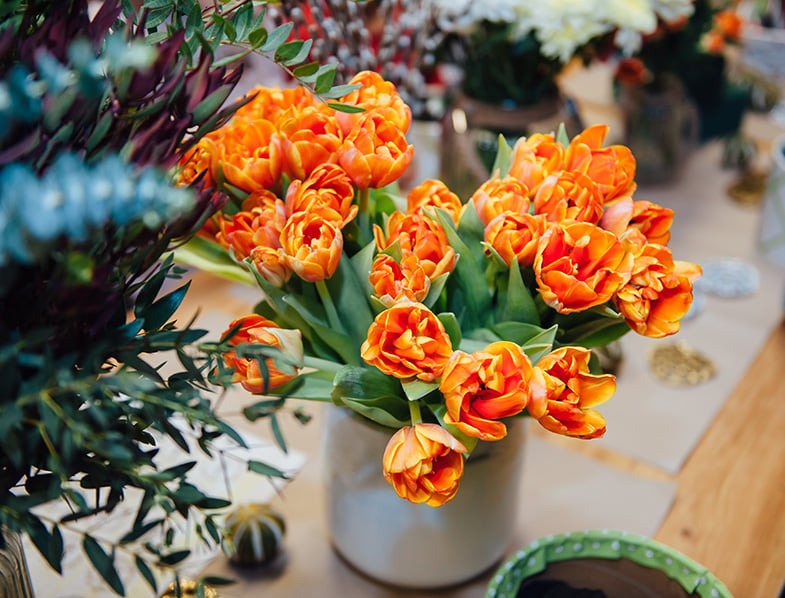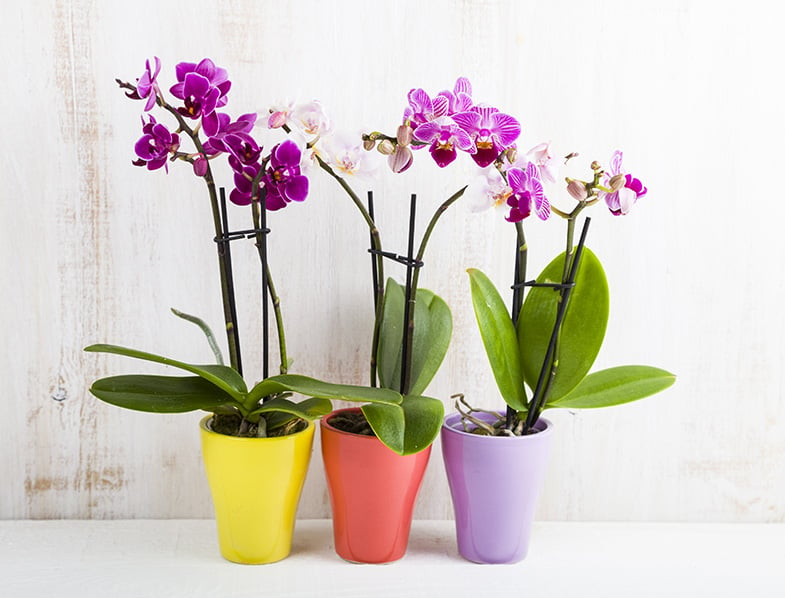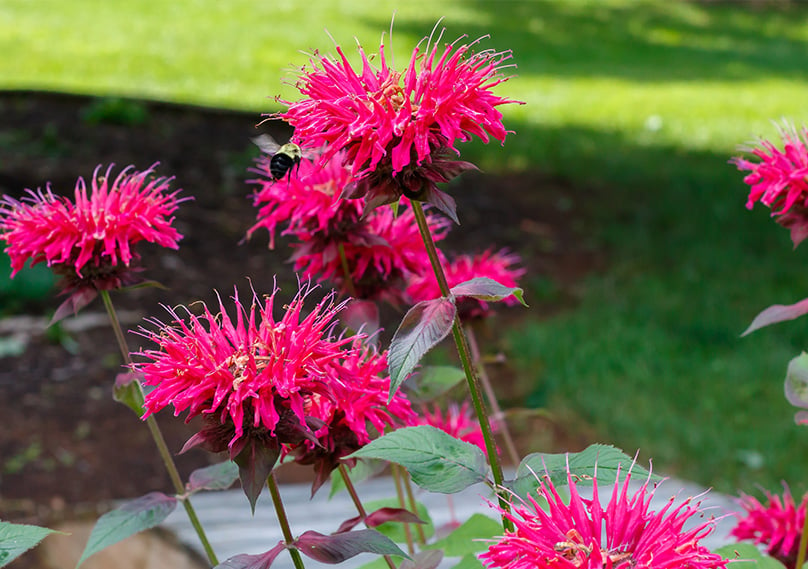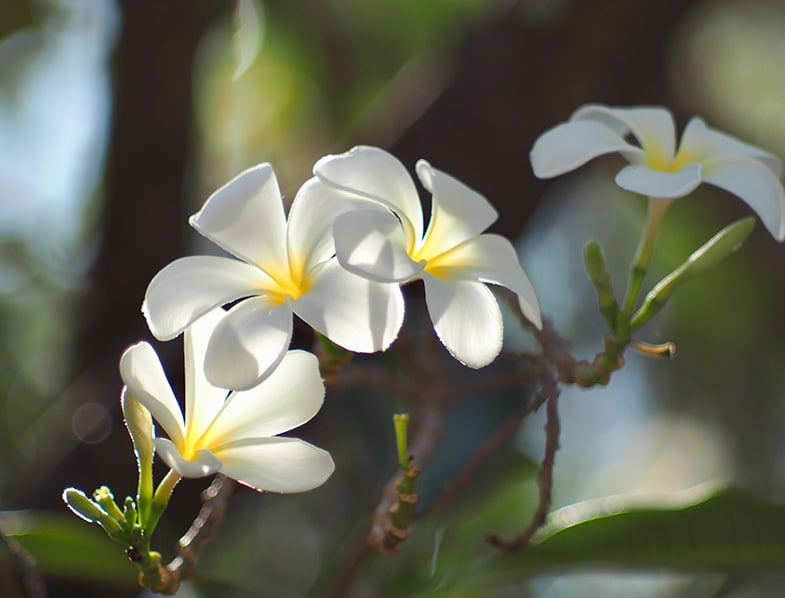Spring is surely one of the most exciting seasons for gardeners that love flowering plants!
And when the warmth and happiness of the seasons arrive, it is best to be prepared. So, are you ready to add another beauty to your plant family? Still cannot decide what baby plant will be next? Well, this is the perfect time for us to step in! Keep reading to find out more about our top flowering houseplants and why we are so in love with them.
Stephanotis Floribunda (Madagascar Jasmine)
Stephanotis floribunda plants have a good reputation thanks to their shiny dark green foliage and waxy white flowers. Gardeners often refer to these vines as Madagascar jasmines because they have a mesmerizing scent and produce cute blooms that resemble jasmines.

They make for an excellent addition to any indoor decoration and it is best to grow them in environments that simulate the tropical conditions of their natural habitat. If you want to grow them as ornamental houseplants, you should know that Stephanotis floribunda vines can reach from 3 to 4 feet (0.9-1.2 m) in height. That means that you might want to consider growing them in large pots.
In the language of flowers, Stephanotis floribunda plants represent marital harmony. Therefore, it is quite common to hear people call these flowers bridal bouquets, bridal wreaths, or bridal veils because they play an important role in wedding arrangements. As filler plants, the blossoms of Stephanotis bring a significant amount of perfume to bridal bouquets without taking up too much space.
Miniature Roses
Although most gardeners grow roses in gardens or greenhouses, there are some tiny cultivars that you can grow indoors to enjoy their unique fragrance. Miniature Roses are lovely flowering species that can remain small in size thanks to selective breeding. These plants come in hundreds of varieties, but they are primarily climbers (vertical rambling growth) and trailers (lazy cascading growth). The smallest miniature Roses are known as micro-mini.

Miniature Roses have a lot in common with standard rose bushes, however, their flowers are obviously smaller. They usually bloom from late spring to summer, producing flowers with a wide range of colors including white, pink, yellow, red, and pleasant mixes.
Despite their dwarf dimension, these plants are extremely tolerant of any environmental condition. In fact, they are more frost-hardy than most species of roses and tend to bloom sporadically with proper care.
Orchids
When in doubt, Orchids are just around the corner waiting for you to bring them home! These flowering plants are highly diverse and popular worldwide. Gardening enthusiasts appreciate them mostly for their stunning blossoms that come packed with a pleasant perfume. And if you cannot decide on one color, there will always be numerous varieties with white, yellow, pink, purple, lavender, and even blue or green flowers to choose from.

Orchids will bring a nice dash of personality to their surroundings without much effort, especially on your part! If you want to grow these plants indoors, they will thrive when provided with plenty of bright light, warm temperatures, and moderate levels of humidity. The best thing about Orchids is that they require little care once established.
Passiflora
If you are looking for houseplants that put on display an exotic presence, Passiflora flowers might be the perfect choice for you! Whether it is their hypnotic flowers or the curious fragrance that will charm you endlessly, these colorful and joyful plants will reward you with their blossoms.

Their intensely colored flowers are one of a kind and, after their blooming period, they turn into well-known passion fruits. You can use the fruits in several culinary recipes, such as desserts, jellies, or jams. The juice of passion fruits is also a favorite flavoring in beverages.
Passiflora plants come along with an interesting history and a bag full of appreciation for their medical benefits. In traditional medicine, these herbs were used as a treatment for various conditions including insomnia, anxiety, hypertension, and skin burns. Overall, Passiflora plants go beyond ornamental purposes and worth all the effort on your part to care for them!
Hoya Plants
What makes Hoya plants one of the most popular ornamental houseplants worldwide is their spectacular appearance and easy-going style. You can find them under many different names including Waxplants, Waxflowers, or Waxvines. These tropical plants come with tiny and adorable flowers that can bring a dash of personality to any indoor decoration. Just wait and see them in action!

Although all Hoya flowers are shaped like five-pointed stars, they have a wide diversity of colors and fragrances. First things first, the waxy and star-shaped flowers exhibit lovely mixes of white, pink, yellow, red, purple, and green. And when it comes to their perfume, Hoyas will mesmerize even the pickiest noses with scents that resemble chocolate, vanilla, citrus, lemon, or orange.
Lily of the Valley
Thanks to their delicate and sweet-scented flowers, Lily of the Valley plants got the prestigious Award of Garden Merit. They make for great houseplants anywhere around the world so you simply must grow them in your home. These beauties are often used to produce various fragrant indoor sprays, which are not always a healthy option. So why not perfume your home with the natural source instead? You do not want to miss their relaxing perfume during the spring and summer months!

Lilies of the Valley are herbaceous plants that come along with many small, bell-shaped, and white or rarely pink flowers. Once their blooming season has ended, the pretty blossoms turn into orange-red berries that look absolutely fabulous among their luxuriant green foliage.
Growing and caring for these flowering plants can be a delightful experience. However, if you have curious children or pets around your house, you must find the safest location for both parties. All parts of Lilly of the Valley are potentially toxic, but you can avoid unpleasant incidents if you place your plants in a spot where your loved ones cannot reach them.
Bee Balm
The best thing about Bee Balm plants is their perennial feature. These plants have to ability to come back year after year to add vibrant colors to your surroundings. Big lovers of sunlight and lots of moisture, Bee Balm plants will do just fine if you place them in the brightest spots of your house and provide them with regular watering.
A bonus tip: they are highly attractive to butterflies, bees, and hummingbirds, so you can try to put your plants on windowsills to allow pollinators to enjoy their juicy flowers.

Bee Balm plants exhibit daisy-like flowers that usually come in various shades of pink, red, purple, and white. You might be tempted to think that their flowers are the reason why these beauties smell so nice, but surprise! The only fragrant components of these plants are their leaves, which are reminiscent of the citrusy bergamot oranges.
People have been using the leaves of Bee Balm plants o prepare spicy-scented essential oils for a long time. Moreover, they have a well-known reputation as herbaceous medicinal plants. They play an important role in traditional medicine as treatments for skin infections, wounds, infections, fever, and headache.
These plants taste like a mix of peppermint, spearmint, and oregano, so you can always replace these ingredients in your recipes with Bee Balm leaves.
Plumeria
Plumeria plants are very charming shrubs or small trees that you can grow in adorable pots without much effort. Although they might seem exotic and complicated, Plumeria plants are somehow drought-tolerant and can thrive in almost any environmental condition. Coming with over 360 registered cultivars, these flowering plants have a higher chance to meet your expectations and win your heart forever than many other houseplants!

Elegant in their nature, these tropical plants produce gorgeous flowers that can appear in pleasant-looking mixes of white, yellow, orange, red, pink, purple, green, and blue. Their flowers are iconic in Hawaiian culture, where you can see them very often, especially in garlands of flowers that women wear around their necks.
Heliotropium
You can distinguish Heliotropium plants not only through their tiny and cute blossoms but also their shiny, sometimes hairy foliage. These weeds can make for excellent companions for a long time with little care. However, they will demand constant chit-chat and all the love that you can give them!

Their white, blue, or purple flowers appear in many clusters on stems that tend to grow in alluring spirals. Many gardeners describe the fragrance of Heliotropium flowers as strong, quite similar to hawthorns, narcissus, vanilla, or apples. Although you can grow these plants safely around curious children, they can be pretty poisonous to cats and dogs if ingested.
Jasmine
Jasmines have been widely cultivated worldwide mostly for the characteristic perfume of their bloomings. These flowering plants have cultural importance, being used very often in the perfume industry, festivals, religious ceremonies, and common rituals like marriages.

They can be climbing or spreading vines and shrubs that look absolutely stunning when planted in hanging baskets or pots with lovely natural supports. Their flowers can be creamy-white, yellow, or rarely slightly reddish with aphrodisiac and medicinal properties. After a long day of work, you can always take a nice break along with your baby plants and some flavored tea prepared from Jasmine flowers.
In Conclusion
With spring just around the corner, you simply cannot miss the opportunity to enjoy the distinguished and mesmerizing fragrances of these blossoms! What ornamental flowering plants will be your next companions? Let us know in the comment section!
